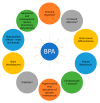Additives in Processed Foods as a Potential Source of Endocrine-Disrupting Chemicals: A Review
- PMID: 39584955
- PMCID: PMC11587131
- DOI: 10.3390/jox14040090
Additives in Processed Foods as a Potential Source of Endocrine-Disrupting Chemicals: A Review
Abstract
Processed foods, accounting for most consumable food categories today, contain considerable amounts of food additives. Food additives are substances added to food products to improve taste, consistency, appearance, or shelf life. Various food additives, such as phthalates, bisphenol A, tartrazine, erythrosine, artificial sweeteners, and parabens, have been identified as potential sources of endocrine-disrupting chemicals (EDCs) in processed foods. EDCs are substances that frequently interfere with the regular functioning of the endocrine system, creating an unusual environment in the biological system, which leads to adverse health effects such as the disruption of hormone synthesis, receptor binding, and signal transduction pathways, as well as energy metabolic homeostatic disorders which potentially increasing the risk of obesity, type-2 diabetes, cardiometabolic diseases and may also trigger allergic reactions. Consequently, they can also impact mammary gland development, and reproductive function, further leading to developmental abnormalities. This review aims to insights into the various food additives that act as potential endocrine-disrupting chemicals (EDCs) and to describe their applications in the food industry, as well as the failure of hormonal homeostatic mechanisms, which eventually result in hazardous health effects. It also outlines strategies to reduce the use of food additives and suggests alternative additives with minimal or no endocrine-disrupting properties, highlighting their importance for maintaining human health.
Keywords: developmental effects; endocrine-disrupting chemicals; food additives; gene expression; receptor binding; thyroid dysfunction.
Conflict of interest statement
The authors declare no conflicts of interest.
Figures




References
-
- Amin K.A., Al-Shehri Fawzia S. Toxicological and safety assessment of tartrazine as a synthetic food additive on health biomarkers. Afr. J. Biotechnol. 2018;17:139–149.
-
- Lorenzoni A., Oliveira F.A., Cladera O. Florencia. Food Additives in Products for Children Marketed in Brazil. Food Public Health. 2012;2:131–136. doi: 10.5923/j.fph.20120205.03. - DOI
Publication types
LinkOut - more resources
Full Text Sources

